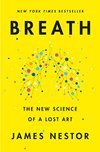
Saved by Daniel Wentsch and
Breath: The New Science of a Lost Art

Saved by Daniel Wentsch and
some of these researchers were also showing that many modern maladies—asthma, anxiety, attention deficit hyperactivity disorder, psoriasis, and more—could either be reduced or reversed simply by changing the way we inhale and exhale.
By your 3,000th breath, you’ll know the basics of restorative breathing.
manuscripts included detailed instructions on how to regulate the breath, slow it,
For every ten pounds of fat lost in our bodies, eight and a half pounds of it comes out through the lungs; most of it is carbon dioxide mixed with a bit of water vapor. The rest is sweated or urinated out. This is a fact that most doctors, nutritionists, and other medical professionals have historically gotten wrong. The lungs are the
... See moreBut anaerobic energy is inefficient and can be toxic, creating an excess of lactic acid. The nausea, muscle weakness, and sweating you experience after you’ve pushed it too hard at the gym is the feeling of anaerobic overload. This process explains why the first few minutes of an intense workout are often so miserable.
I’d read a report from the Mayo Clinic which found that chronic insomnia, long assumed to be a psychological problem, is often a breathing problem. The millions of Americans who have a chronic insomnia disorder and who are, right now, like me, staring out bedroom windows, or at TVs, phones, or ceilings, can’t sleep because they can’t breathe.
The problem was that this smaller, vertically positioned nose was less efficient at filtering air, and it exposed us to more airborne pathogens and bacteria. The smaller sinuses and mouth also reduced space in our throats. The more we cooked, the more soft, calorie-rich food we consumed, the larger our brains grew and the tighter our airways
... See moremouthbreathing is destroying our health.
What if overbreathing wasn’t the result of hypertension and headaches but the cause? Buteyko wondered. Heart disease, ulcers, and chronic inflammation were all linked to disturbances in circulation, blood pH, and metabolism. How we breathe affects all those functions. Breathing just 20 percent, or even 10 percent more than the body’s needs could
... See more